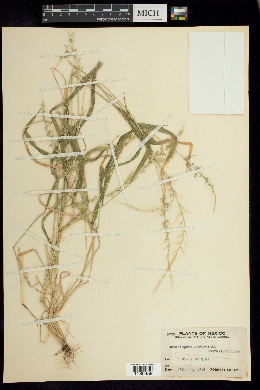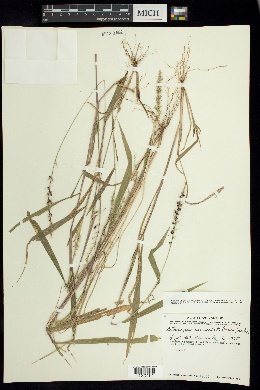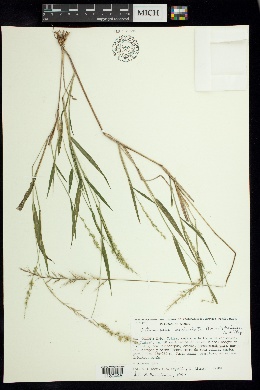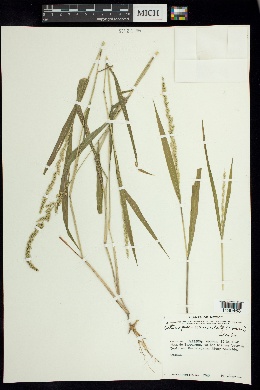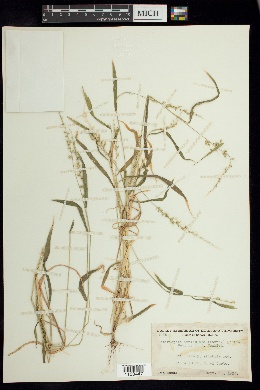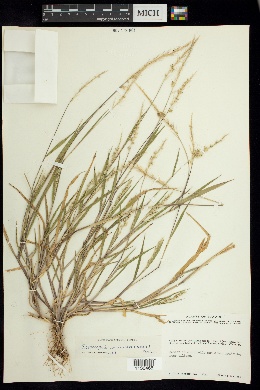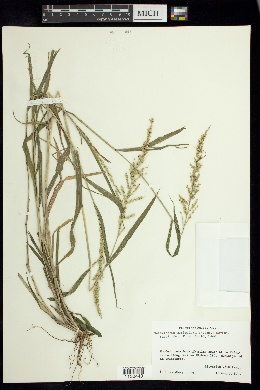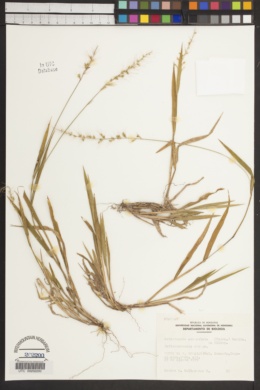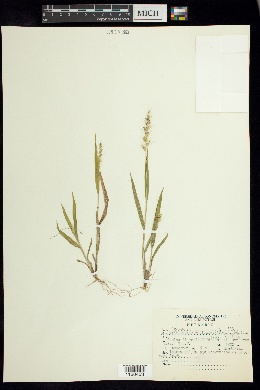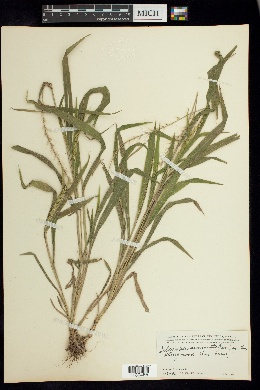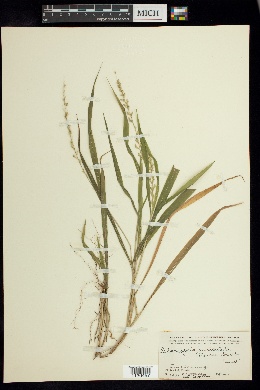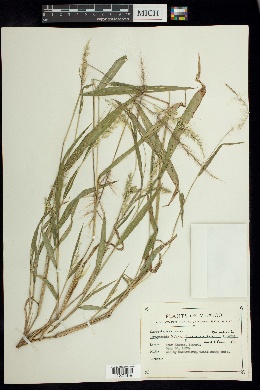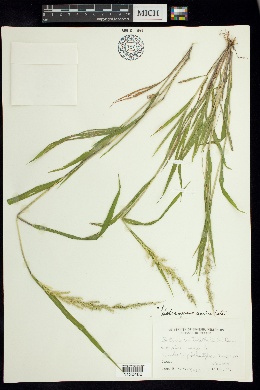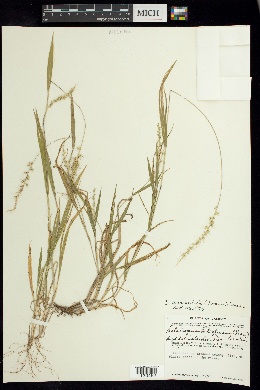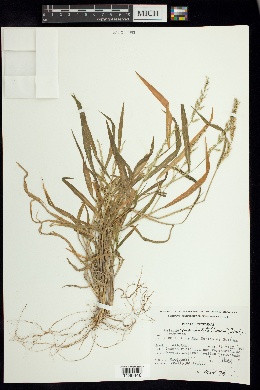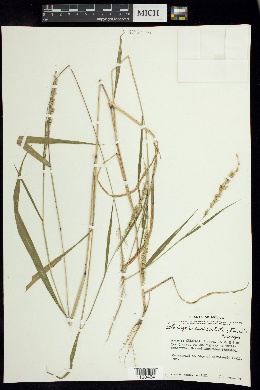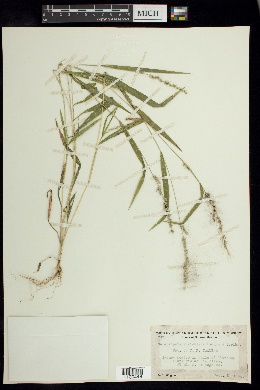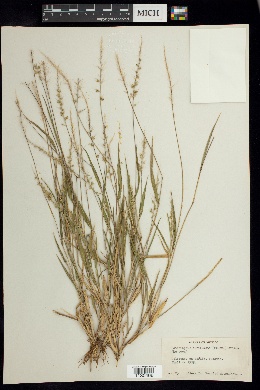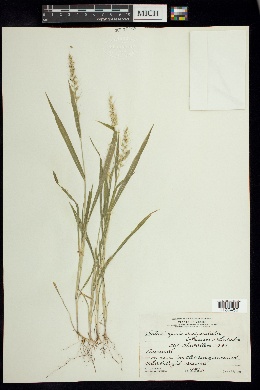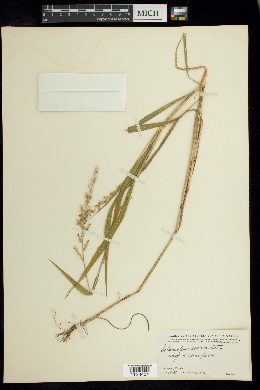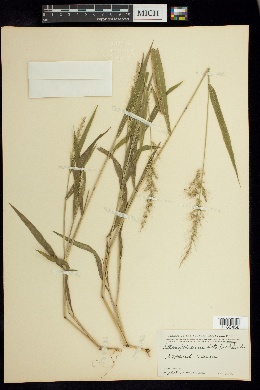Setariopsis auriculata
|
|
|
|
Family: Poaceae
Eared False Foxtail
[Setaria auriculata var. depauperata E. Fourn., moreSetaria pauciseta , Setariopsis scribneri Mez] |
Culms 20-70 cm, weak, erect or ascending, glabrous or with a few, short, appressed hairs on and immediately below the nodes. Sheaths mostly glabrous but with soft hairs near the ligule; ligules 1-1.5 mm; blades to 20 cm long, 5-15 mm wide, glabrous or with a few hairs on the collars. Panicles 8-16 cm long, 0.8-1.5 cm wide; branches 0.5-3.5 cm; bristles 3-10 mm, antrorsely barbed. Spikelets 3-3.5 mm, ovate, acute. Lower glumes about 1 mm long, 1.5 mm wide, inflated; upper glumes 2.7-3.2 mm, ovate, somewhat inflated, abruptly constricted below, margins resembling auricles, apices acute or obtuse; lower lemmas ovate-triangular, indurate in the lower 1/3 where the spikelet narrows; upper lemmas 2-2.5 mm, finely and transversely rugose, acute and apiculate; anthers 0.8-1 mm, purple. 2n = 18. Setariopsis auriculata was recently found to be established in Arizona (Reeder 2001), growing in moist, shady habitats. Prior to this discovery, its range was considered to extend from northern Mexico to Nicaragua, Colombia, and Venezuela. FNA 2003 Common Name: setariopsis Duration: Annual Nativity: Native Lifeform: Graminoid General: Annual grasses, often tufted, 20-70 cm tall; stems weak, erect or ascending, glabrous or with a few short, appressed hairs on and immediately below the nodes. Vegetative: Sheaths open, mostly glabrous but with soft hairs near the ligule; ligules of hairs, 1-1.5 mm; blades flat, to 20 cm long, 5-15 mm wide, glabrous or with a few hairs on the collar. Inflorescence: Terminal panicles, 8-16 cm long, 1 cm wide, with pilose rachises; branches 0.5-3.5 cm; spikelets shortly pedicellate, each pedicel subtended by a 3-10 mm, antrorsely barbed bristle; disarticulation below the glumes. Spikelets 3-4 mm, ovate, acute, with 2 florets, lower florets usually sterile, upper florets bisexual; lower glumes 1 mm long, 1.5 mm wide, 5-7-veined, subclasping, inflated; upper glumes 3 mm, 11-19-veined, indurate at maturity, with an auriculate base; lower lemmas longer than the glumes, indurate in the lower 1/3 where the spikelet narrows; upper lemmas 2 mm, finely and transversely rugose. Ecology: Found in moist, shady habitats, below 4,000 ft (1219 m); flowers August-September. Distribution: s AZ and MEX, south through C. Amer. to Columbia and Venezuela. Notes: Setariopsis is a genus of grasses that strongly resemble the more familiar Setaria. In Setaria, the fertile lemma and palea of each spikelet are indurate (hardened); Setariopsis shares this trait, but in addition, second glume and the lower portion of the sterile lemma are also indurate. S. auriculata is an annual grass with weak, often geniculate stems and loose, often interrupted, narrow spikelike panicles. Quite similar to Setaria grisebachii; in addition to the spikelet differences described above, S. grisebachii tends to be a little more robust, its panicles often denser with spikelets although still sometimes interrupted, and the bristles a bit longer (5-15 mm). S. auriculata was recently found to be established in Arizona (Reeder 2001), growing in moist, shady habitats. Prior to this discovery, its range was considered to extend from northern Mexico to Nicaragua, Columbia, and Venezuela. It is known from very few sites in Southern Arizona. Look for it on wash banks from Tucson to the border. Ethnobotany: Unknown Etymology: Setariopsis means resembling the genus Setaria; the name Setaria, in turn, is from Latin saeta, a bristle or hair; auriculata is from the Latin for -ear- and refers to the ear-like appendages at the base of the upper glumes. Editor: SBuckley 2014, AHazelton 2015 |













































